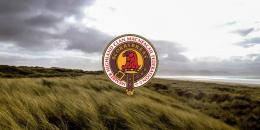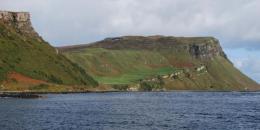The Isle of Skye, (Scottish Gaelic: An t-Eilean Sgitheanach or Eilean a' Cheò) is located off the West coast of the Scottish mainland, and is the largest and most northerly island of the Inner Hebrides. The peninsulas of Skye are often compared to the wings of a bird; Trotternish in the north, Waternish, Duirinish, Minginish and Strathaird to the west and Sleat are those coastline peninsulas.
The Clan settled in Skye after having lost the ancient lands once occupied on the Isle of Lewis to the MacLeods, and for 800 years lived on the East Coast of Skye just North of Portree. The serene and peaceful peninsula of Trotternish where our traditional Clan Lands are located has many walking paths to include the Scorrybreac Trails.
There are many beautiful poems, ballads and stories that describe life on the Isle of Skye. The following is an extract from the book, The Misty Isle of Skye, by J.A. MacCulloch, Oliphant, 1910, which describes the traditional lands of the Clan and the Chief.
 A Footnote on the clan lands
A Footnote on the clan lands
From The Misty Isle of Skye,
by I.A. MacCulloch, Oliphant, 1910
This excerpt from a book published 100 years ago was used in the publicity effort we made in 1986/7 towards the purchase of the clan lands at Ben Chracaig. It describes quite lyrically the land on the seaward side facing the Sound of Raasay…..
Thus it is easy to see that the natural surroundings of Portree make it what it is, and this suggests a closer treatment of some of them. The tourist who makes Portree their headquarters, and from there dashes off to see the Quiraing or Coruisk, or the Cuillins, or Dunvegan, knows little of the charming “bits” so near at hand, where so much variety and beauty is spread before and around one. If he be of an independent turn of mind, he may discover some of them for himself, but this seldom happens, and their true value remains known only to those who live year in year out in their midst, and can wander to them at the appropriate season.
Between the two frowning basaltic cliffs on the north side of the entrance to the bay the oolite which everywhere underlies the basalt is exposed to view. It runs sloping upwards in long yellow strata full of fossils far above the blue waters, and on its top lies a lush green meadow. In one or two places wind and weather have eroded the cliff and left great hollows under a canopy of stone where one may sit in quiet and look down on the placid sea or watch the lights and shadows changing on the rugged face of Ben Tianavaig across the bay. Here and there a limpid fountain trickles down through a deep crevice lined with thick curtains of moss, where lurk hartstongue ferns and black maidenhair, or in the drier cracks of the limestone the rare little wall-rue or the glossy sea spleenwort. Thyme overhangs the cliff’s edge, and the oolite is everywhere channeled and grooved, and in these grooves and channels ivy has taken a firm hold, so that it sometimes completely hides the rock beneath a deep green mantle. Its roots, where they are exposed, are of the thickness of a man’s arm. In the meadow which runs inshore grow hemlock, meadow-sweet, and purple vetch, often as high as one’s head; in the more barren patches peep blue violets, masses of eyebright, the green sun-spurge, the golden buttercup, or, earlier in the year, the pale primrose and the purple hyacinth.
A little beyond are the crumbling stones of one of those tiny ancient Celtic churches, rude in architecture, in which the voice of praise has long been silent, and where the too luxurious vegetation girdles the long-forgotten graves, and lulls them into a deeper sleep. But not all, for there is one stone of recent erection with a touching epitaph. It tells of a sailor who, weary of life, committed suicide in the loch. He was buried here, not in the parish churchyard, and rumour hints darkly of those who, thinking even this ancient place of graves too sacred for the bones of one who had raised an impious hand against himself, cast him back once more into the sea. Peace be to his soul, wherever his body lies. “He was a faithful servant to his earthly master.”
A ludicrous story attaches itself to this place. Two solitary trees rise gaunt and high among the deserted ruins. They mark the graves of the successive wives of an islander who kept their memory green by these memorials, but who, when his time came that men should gird and carry him, found none to do the like for him.
Above this old churchyard is a narrow glen down which a burn trickles to the sea. It terminates in the precipitous flank of the cliff, over which the water dashes, through masses of birch and hazel, forming a cool, shadowy grotto with deep recesses where lurk asplenia and hollyfern in plenty. All around are thick clumps of fern and bracken, beds of yellow primroses, blue violets, white anemones, while the air is scented with their perfumes and the aromatic odour of the bracken. Overhead is the black frowning cliff, looking as if it would suddenly dash itself downwards. Beyond it is the ruined heap of Dun Torvaig, and near by the gable of the ancient house of Scorrybreck. Somewhere here Prince Charles hid from his pursuers after having crossed to Skye from Raasay, beyond the sound. Far below are the ruined church, the green meadow, the rolling sea. In front is Creag Mhor, rising skywards; across the water is Raasay and the steep flanks of Ben Tianavaig, and in the far distance Ben Alligin looks down upon the glories of Loch Torridon. You see all this on an early summer day, when sea and sky are sapphire and a haze hangs over the slopes of Raasay with their variegated surface of brown and grey and green. The lambs are calling, the plovers are shrieking, the gulls poising themselves irresolutely in mid-air, and then, with a wild cry, darting off into the far distance; some fishing boats are putting out to sea, their brown sails now bellying, now collapsing, as they tack hither and thither, seeking for a breeze. These are the only signs of life in the joyous landscape, and you feel how good a thing it is to be alive, while the air is full of the tang of the sea and the perfumes of summer, and the eye rests gladly on the beauty of earth and sea.

Looking across the Sound of Raasay to the Isle of Raasay, as described in the last paragraph. Ben Tianavaig is on the right, beyond the salmon fisheries near the shore.







